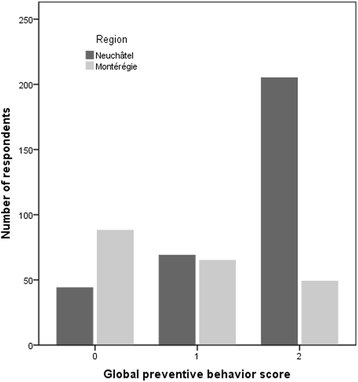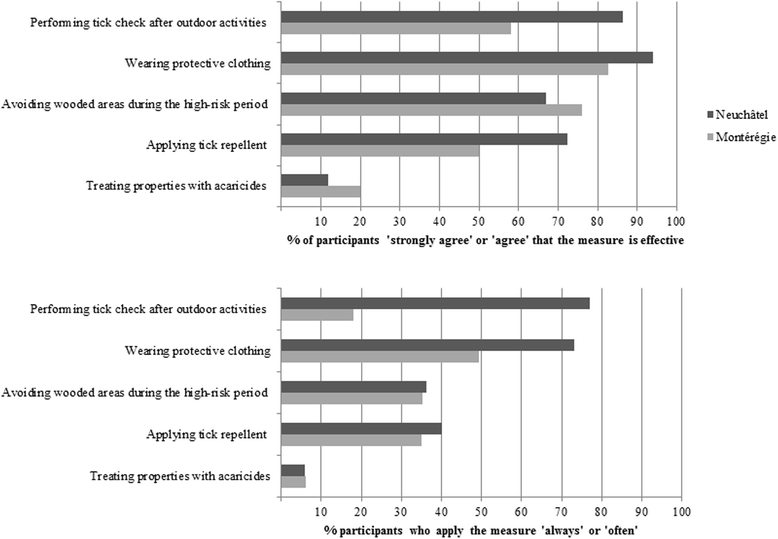Factors associated with preventive behaviors regarding Lyme disease in Canada and Switzerland: a comparative study
- PMID: 25884424
- PMCID: PMC4349712
- DOI: 10.1186/s12889-015-1539-2
Factors associated with preventive behaviors regarding Lyme disease in Canada and Switzerland: a comparative study
Abstract
Background: Lyme disease (LD) is a vector-borne disease that is endemic in many temperate countries, including Switzerland, and is currently emerging in Canada. This study compares the importance of knowledge, exposure and risk perception for the adoption of individual preventive measures, within and between two different populations, one that has been living in a LD endemic region for several decades, the Neuchâtel canton in Switzerland, and another where the disease is currently emerging, the Montérégie region in the province of Québec, Canada.
Methods: A web-based survey was carried out in both study regions (814 respondents) in 2012. Comparative analysis of the levels of adoption of individual preventive measures was performed and multivariable logistic regression analyses were used to test and compare how knowledge, exposure and risk perception were associated with the adoption of selected measures in both regions and globally.
Results: In Montérégie, the proportion of reported adoption of five of the most commonly recommended preventive measures varied from 6% for 'applying acaricides on one's property' to 49% for 'wearing protective clothing', and in Neuchâtel, proportions ranged from 6% (acaricides) to 77% for 'checking for ticks (tick check)'. Differences were found within gender, age groups and exposure status in both regions. The perceived efficacy of a given measure was the strongest factor associated with the adoption of three specific preventive behaviors for both regions: tick check, protective clothing and tick repellent. Risk perception and a high level of knowledge about LD were also significantly associated with some of these specific behaviors, but varied by region.
Conclusions: These results strongly suggest that social and contextual factors such as the epidemiological status of a region are important considerations to take into account when designing effective prevention campaigns for Lyme disease. It furthermore underlines the importance for public health authorities to better understand and monitor these factors in targeted populations in order to be able to implement preventive programs that are well adapted to a population and the epidemiological contexts therein.
Figures
Similar articles
-
From Lyme disease emergence to endemicity: a cross sectional comparative study of risk perceptions in different populations.BMC Public Health. 2014 Dec 18;14:1298. doi: 10.1186/1471-2458-14-1298. BMC Public Health. 2014. PMID: 25523355 Free PMC article.
-
Acceptability of tick control interventions to prevent Lyme disease in Switzerland and Canada: a mixed-method study.BMC Public Health. 2016 Jan 5;16:12. doi: 10.1186/s12889-015-2629-x. BMC Public Health. 2016. PMID: 26733007 Free PMC article.
-
Exposure and preventive behaviours toward ticks and Lyme disease in Canada: Results from a first national survey.Ticks Tick Borne Dis. 2017 Jan;8(1):112-118. doi: 10.1016/j.ttbdis.2016.10.006. Epub 2016 Oct 13. Ticks Tick Borne Dis. 2017. PMID: 27771334
-
Prevention of Lyme disease.Am J Hosp Pharm. 1992 May;49(5):1164-73. Am J Hosp Pharm. 1992. PMID: 1595748 Review.
-
American Academy of Pediatrics. Committee on Infecious Diseases. Prevention of Lyme disease.Pediatrics. 2000 Jan;105(1 Pt 1):142-7. Pediatrics. 2000. PMID: 10617720 Review.
Cited by
-
Who is afraid of ticks and tick-borne diseases? Results from a cross-sectional survey in Scandinavia.BMC Public Health. 2019 Dec 11;19(1):1666. doi: 10.1186/s12889-019-7977-5. BMC Public Health. 2019. PMID: 31829150 Free PMC article.
-
Spatial Clusters and Non-spatial Predictors of Tick-Borne Disease Diagnosis in Indiana.J Community Health. 2019 Dec;44(6):1111-1119. doi: 10.1007/s10900-019-00691-0. J Community Health. 2019. PMID: 31270657
-
Learning to live with ticks? The role of exposure and risk perceptions in protective behaviour against tick-borne diseases.PLoS One. 2018 Jun 20;13(6):e0198286. doi: 10.1371/journal.pone.0198286. eCollection 2018. PLoS One. 2018. PMID: 29924806 Free PMC article.
-
Low Risk Perception about Ticks and Tick-Borne Diseases in an Area Recently Invaded by Ticks in Northwestern Italy.Vet Sci. 2021 Jul 13;8(7):131. doi: 10.3390/vetsci8070131. Vet Sci. 2021. PMID: 34357923 Free PMC article.
-
Can protection motivation theory predict protective behavior against ticks?BMC Public Health. 2023 Jun 22;23(1):1214. doi: 10.1186/s12889-023-16125-5. BMC Public Health. 2023. PMID: 37349761 Free PMC article.
References
-
- Ferrouillet C, Lambert L, Milord F: Consultation sur l’état actuel de la surveillance des zoonoses au Québec et son adéquation avec les changements climatiques et écologique. Québec: Institut national de santé publique du Québec; 2012:147.
-
- Nahimana I, Gern L, Peter O, Praz G, Moosmann Y, Francioli P. [Epidemiology of Lyme borreliosis in French-speaking Switzerland] Schweiz Med Wochenschr. 2000;130(41):1456–1461. - PubMed
Publication types
MeSH terms
LinkOut - more resources
Full Text Sources
Other Literature Sources
Medical
Research Materials



